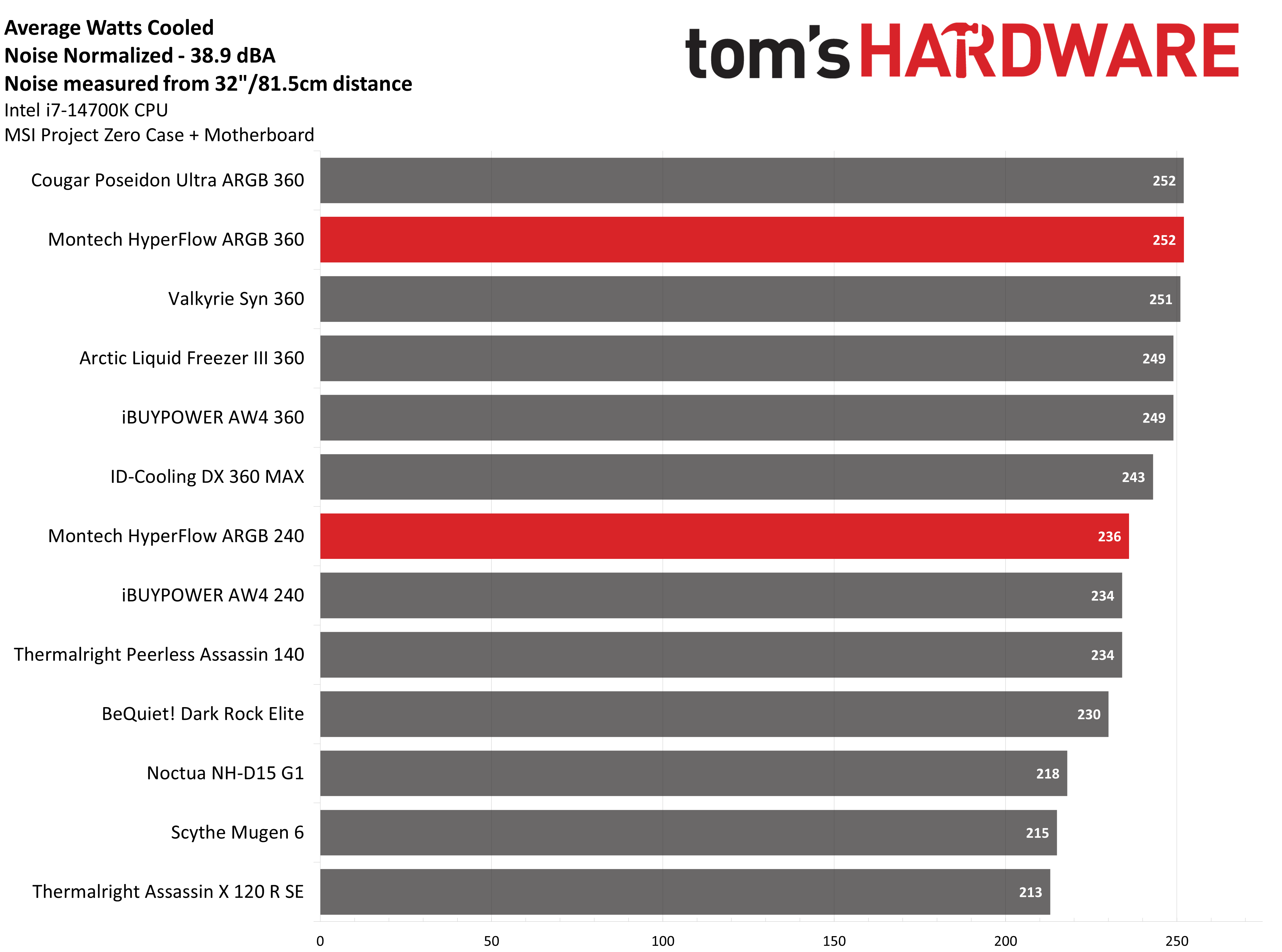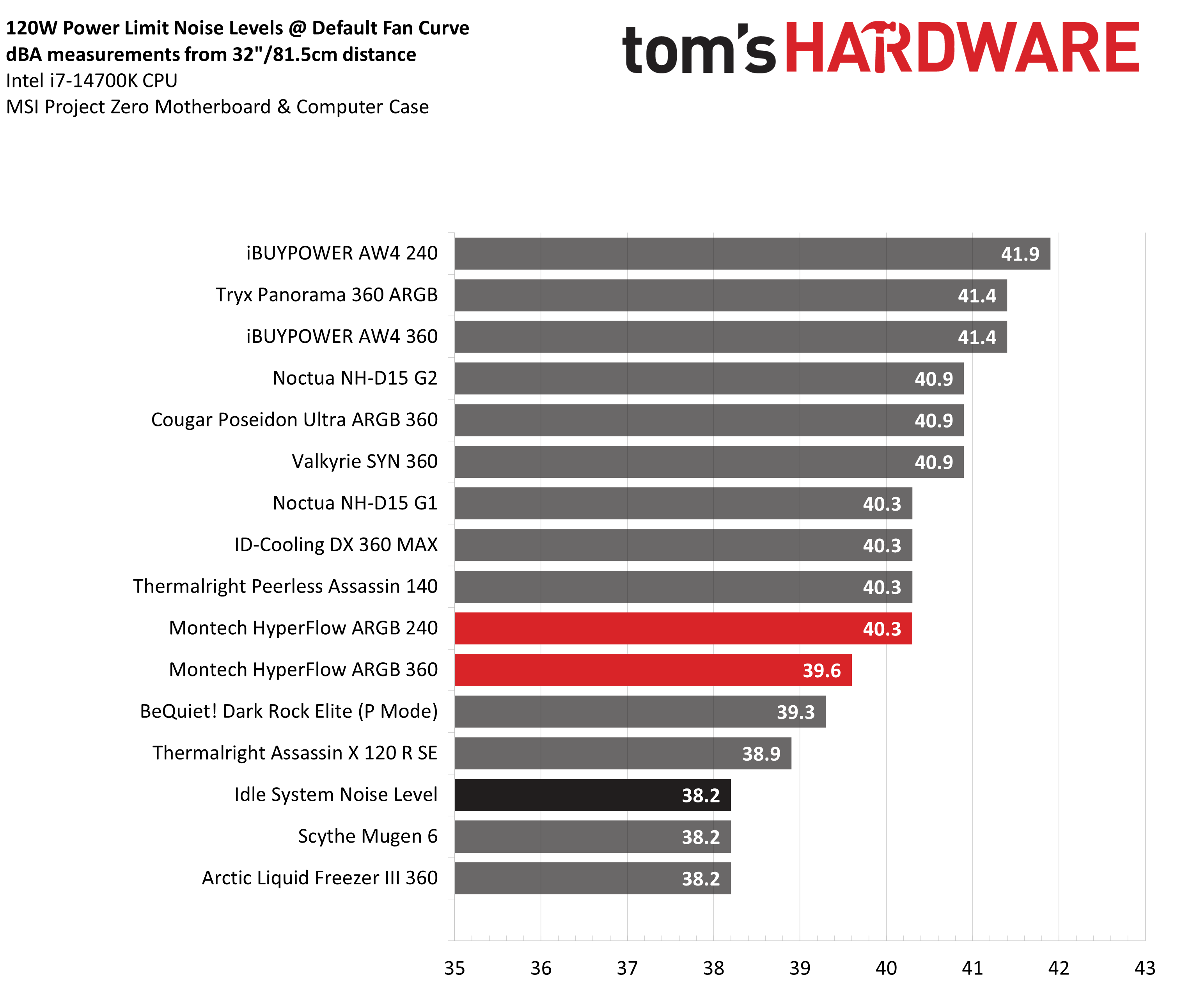Why you can trust Tom's Hardware
CPU Thermal results without power limits
Without power limits enforced on Intel’s i7-14700K, it will hit its peak temperature (TJ Max) and thermally throttle with even the strongest of air coolers. When the CPU reaches its peak temperature, I’ve measured the CPU package power to determine the maximum wattage cooled to best compare their performance. This includes AIOs like the 240mm version of the Hyperflow ARGB, which cooled 256W on average during the course of testing. This technically results in minor thermal throttling, but the amount is so small that one would not notice the difference unless you were recording benchmarks.
The very best of AIOs on the market can keep Intel’s i7-14700K under its peak temperature in this test, but this is no small task. Testing Cinebench without power limits was hard on coolers even when paired with last generation’s i7-13700K, but the task is even more difficult using a Raptor Lake i7 CPU, because it has more cores and higher clock speeds. I fully expect most AIOs to “fail” this test and thermally throttle to a small extent. While the 240mm version of Montech’s Hyperflow ARGB fails this test, the 360mm version is one of the few AIOs I’ve tested capable of passing this test – averaging 93C during the course of testing.
To sustain this top-tier level of thermal performance, the fans of the 360mm reach up to 49.8 dBA. This is a fairly loud level, but I feel like most users who want the absolute best performance on the market won’t mind it – especially given the product’s low price. The 240mm model runs slightly quieter, at 48.7 dBA.
Note that our chart above starts at 35dBA, which is unusual. But we aren’t doing this to be deceptive. First, noise level measurements are logarithmic. A person with typical hearing will perceive a doubling of noise for every 10 dBA increase, but the impact can vary from person to person. Second, 35dBA was chosen as the “zero” because it is the lowest level my noise meter can accurately measure.
Thermal results with noise normalized to 38.9 dBA
Finding the right balance between fan noise levels and cooling performance is important. While running fans at full speed can improve cooling capacity to some extent, the benefits are limited and many users prefer a quieter system. With this noise-normalized test, I’ve set noise levels to 38.9 dBA. This level of noise is a low volume level, but slightly audible to most people.
The 360mm model of the Hyperflow ARGB did especially well when noise normalized, tied for the strongest results of the AIOs we’ve tested with Intel’s i7-14700K. The performance of 240mm version wasn’t quite as impressive, handling a few more watts than strong air coolers.
165W CPU + 275W GPU results
I’ve recently updated my testing methodology to better represent the scenarios a user might actually encounter in real life usage. The first of these new tests is designed to emulate, though not perfectly, a CPU intensive game with a full GPU load. The Montech 360mm AIO had the second-best results I’ve seen with this setup, with a CPU temperature of only 70C. The 240mm version’s performance wasn’t far behind the bigger 360mm variant’s results, trailing it only by 3C with a temperature of 73C.
Get Tom's Hardware's best news and in-depth reviews, straight to your inbox.
When tied to the default fan curve of my motherboard, the fans have a moderate noise level in this test of 45.3 dBA for both the 240mm and 360mm versions of the Hyperflow ARGB.
110W CPU + 275W GPU results
Our second round of CPU + GPU testing is performed with a lower CPU power limit, and in theory should be similar to games that are moderately intensive for a CPU. The Montech Hyperflow ARGB 360 ties with Tryx’s Panorama AIO for the best performance I’ve recorded thus far on this test, averaging only 56 degrees Celsius. Consistent with our previous result, the 240mm model held a temperature 3C higher – measuring 59C. Both of these results are good, thermally speaking.
120W Cinebench results
With my previous testing methodology, I used to record the temperatures and noise measurements using a 125W CPU-only test and I would emphasize how temperatures do not matter in this scenario.
As such, for this section I’m only going to report noise levels – because that’s the only information that really matters for this test. The temperature of the CPU in this scenario is largely irrelevant, but the results for liquid coolers is similar to those reported above in the 110W + GPU tests if you are particularly concerned about this information.
Noise levels were relatively low with both sizes of Montech’s Hyperflow AIO, measuring at 39.6 dBA for the 360mm version and slightly louder at 40.3 dBA for the 240mm model. Ideally, I’d prefer noise levels less than 38.2 dBA in this scenario, but 39.6-40.3 dBA is still reasonably quiet.
Conclusion
Montech’s Hyperflow ARGB 360 shows that strong thermal performance doesn’t have to break the bank. The 360mm model has a budget price of only $94.99 USD, but it can handle the hottest of workloads without breaking a sweat.
- 1
- 2
Current page: Montech Hyperflow ARGB AIO Benchmarks and Conclusion
Prev Page Montech Hyperflow ARGB AIO Features and Specifications
Albert Thomas is a contributor for Tom’s Hardware, primarily covering CPU cooling reviews.
-
Reality_checker What happened to the old test data, Albert? How am I to gauge the performance of this AIO without having the Silverstone IceMyst 360 or Iceberg Thermal IceFLOE Oasis 360 next to it?Reply -
game-tea I don't know about this when the Liquid Freezer III 360 ARGB is available around the same price point.Reply -
thestryker Reply
Albert revamped the testing methodology and test system so no prior data is applicable. I imagine that data will be repopulated as time and availability allow.Reality_checker said:What happened to the old test data, Albert? How am I to gauge the performance of this AIO without having the Silverstone IceMyst 360 or Iceberg Thermal IceFLOE Oasis 360 next to it?








